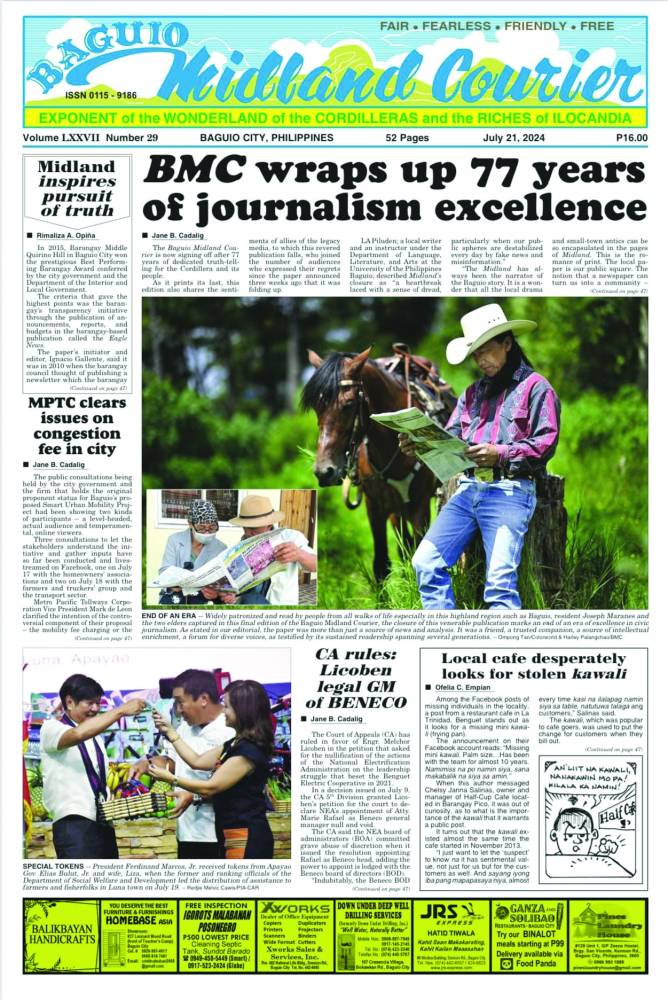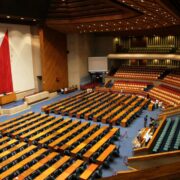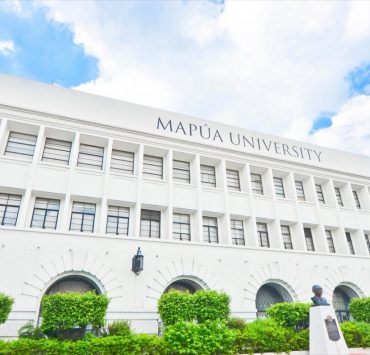Baguio press pillar writes 30

BAGUIO CITY—When its final pages rolled out and the lights at its printing press were switched off for the last time this weekend, the Baguio Midland Courier (BMC) wrote 30 on 77 years of community journalism which its founders began shortly after World War II.
The last headline of the Midland Courier’s final edition on July 21 shows it will leave the business swinging: “BMC wraps up 77 years of journalism excellence.”
It was put to bed by the newspaper’s editorial board composed of editor Harley Palangchao and staff members Jane Cadalig, Rimaliza Opiña, Hanna Lacsamana and Ofelia Empian under the supervision of publisher Gloria Antoinette Hamada, concluding a run that started on April 28, 1947, when literary icon Sinai Hamada and his older brother, Oseo, put together the original 10-centavo, four-page edition for a mountain city that was rebuilding after the war.
The Midland Courier’s roughly 4,000 editions spanning almost eight decades from postwar Baguio to the Luzon 1990 earthquake and to the COVID-19 pandemic in 2020 have been described as “unofficial chronicles” of the city’s history by former editor and now University of the Philippines Baguio communications professor Leia Castro Margate.
In an article she wrote for the Midland Courier’s Oct. 17, 2016 issue, Margate said even the weekly’s advertisements are time capsules of the city’s business history, citing hand-drawn promotions of long gone Indian bazaars Bombay, Pohoomulls and Bheromulls, and the still thriving Chinese-Filipino-run department store, Tiong San.
Baguio’s early set of journalists who honed their skills at the Midland Courier followed the 1948 principle espoused by Sinai, the newspaper’s first editor in chief, who may be more familiar to high school and freshmen college students who read his short story “Tanabata’s Wife” for their classroom assignments.
Sinai wrote: “We shall strive to be read wherever men are fair minded; they are fearless but friendly and free. Fair. To explain: as a newspaper, we shall be a crusader. Having no cause to live for, we have no reason for existence. But espousing or fighting for a cause, we shall be fair before we are fearless. For we have no axe to grind, in the first place.”
Guiding principles
“We are not born of hate, thought of indignation, perhaps…Fearless, though walking in the dark in the search for light. Friendly…by being unselfish. Free. To be free is vital for every newspaper worthy of its name. We are not the tools of any individual or group of people. Beside general and public welfare, we owe no other loyalty,” he said.
The Midland Courier laid the groundwork for more Baguio newspapers. In 1984, Sinai put up a second publication, the Cordillera Post, with his son, Steve, leaving Oseo in charge of the Midland Courier. Cebu media giant SunStar partnered with the late lifestyle columnist Ofelia Dimalanta to publish SunStar Baguio, the city’s only daily newspaper.
All of these newspapers have since folded, but it was the Courier’s shutdown that has jarred other publishers, the Inquirer learned.
Closing a local paper with a 25,000 weekly circulation (as of 2022) reveals the herculean struggles confronting smaller newspapers today.
The end of the Midland Courier was a whispered topic during the July 13 summit of the country’s media councils, which was attended by the Philippine Press Institute (PPI) and the National Union of Journalists of the Philippines at the University of the Philippines Baguio.
Reporters, civil society leaders and journalism students examined why the general public appeared to have lost faith in the media, even in the provinces.
Newspaper readers in Baguio and the Cordillera region, like the rest of the country, have been lured by social media platforms that provide bite-sized news, and many publications that rely on circulation have survived solely on government advertisements and judicial notices, said Brent Martinez, who edits Guru Press in Kalinga province.
This is a limited resource now being fought over by competing newspapers. At the June 8 Baguio City council session, for example, two publishers complained that City Hall advertisements always go to larger publications, only to be told that high circulation was a national procurement law requirement for government notices, bid announcements and proposed laws.
A future problem for community newspapers could be a government plan to allow judicial notices to be posted online in order to reduce the publication expenses shouldered by litigants, which would remove another income source, said Joel Arthur Tibaldo, who runs the Baguio Newseum.
Tibaldo, a retired government employee and among the local journalists behind the Cordillera News Agency, used to be a cartoonist for the defunct Cordillera Post.
Since 2020, provincial journalists have also become targets of Red-tagging, cyberlibel lawsuits and other forms of vilification for pursuing stories that have been critical of the government, said NUJP Cordillera chair Malen Catajan during the media summit.
Palangchao, Catajan said, was attending a forum in Thailand last year when he and other local journalists and activists were labeled “communist terrorists” by the hosts of Sonshine Media Network International’s Laban Kasama ang Bayan.
New frontier
Online newspapers appear to be the new frontier for journalism although some online operators in the provinces are unable to sufficiently “monetize” their digital presence. The Midland Courier launched its website in 2007 while its Facebook page has at least 130,000 followers.
Today’s aspiring community media workers, however, can bridge the gap between technology and serious journalism “because they grew up in the digital age, provided our generation trains them properly in ethical journalism,” said Kimberlie Quitasol, managing editor of the online alternative media outlet Nordis (Northern Dispatch).
“We must also explain to the public the value of community journalism in their lives,” said Cadalig, who helped form the Kordilyera Media-Citizen Council (KMCC). KMCC has organized trips to Cordillera villages for town hall meetings in order to explore and advocate for issues in remote parts of the region.
What is often unsaid about Baguio community journalism is that it was shaped by the Hamadas’ Ibaloy background.
Oseo and Sinai were Japanese-Filipino grandsons of prominent Ibaloy patriarch Mateo Cariño. Cariño won the landmark 1909 United States Supreme Court ruling, which acknowledged his “native” ownership over what is now Camp John Hay. The “Native Title Doctrine” is the foundation for all subsequent laws and judicial rulings that protect indigenous Filipino rights.
“Contrary to the belief of many, the Baguio Midland Courier is not the pioneer newspaper in Baguio. Actually, the first Baguio weekly was the Baguio Banner,” said Dimalanta in a lecture she gave at the July 26, 1994, news industry tribute to brothers Oseo and Sinai at Camp John Hay.
The Banner’s investors partnered with Sinai “and raised P20,000 to purchase a secondhand printing press from Manila…With these, the first few issues of the Midland Courier were printed,” she said. Sinai died in 1991.
Oseo and Sinai’s half sister, Cecile Afable, edited the Midland Courier until her death in 2012. When Oseo died in 1993, his son, Dr. Charles Hamada, steered the Midland Courier as publisher for 23 years. His older sister, Gloria Antoinette, took the helm after Charles died in 2016.
In 1972, the Midland Courier was cited by the Rotary Club of Manila as a model community paper. In 1987, the Rotary Club of Manila again honored the Midland Courier as the Most Outstanding Community Paper in the Philippines.
By 2017, the Midland Courier was elevated to the PPI Hall of Fame, having garnered multiple titles for Best Edited Weekly Newspaper, Best Editorial Page and Best in Science and Environment Reporting, according to the Center For Media Freedom and Responsibility.





















